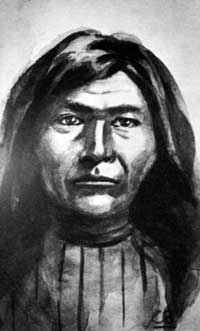|
FORT DAVIS National Historic Site |
 |

Victorio Brings a New Challenge
 Victorio, chief of the Warm Springs Apaches, led his own people and some of the Mescaleros in the outbreak of 1879—80. After Grierson drove him from Texas, he was killed by Mexican. troops. Museum of Nex Mexico |
IN THE YEARS SINCE THEIR SURRENDER, the Mescaleros on the reservation near Fort Stanton had been ringed by white settlements. Mutual suspicion between the two races led to occasional bloodshed. The cattlemen's war in neighboring Lincoln County in 1878 produced an anarchy that had its effect on the Indians. And finally, factional quarrels among the Apaches themselves created further unrest. Some of the more restless people left the reservation and joined their kinsmen in the Guadalupe Mountains and the Texas Big Bend. Others simply used the reservation as a base and a refuge for raids into Texas and Mexico. All that was needed to transform the uncoordinated raids into a full-scale outbreak was a leader. In June 1879 Victorio appeared on the Mescalero reservation.
A dynamic and aggressive chief, Victorio ranked most other Apaches in leadership ability and skill in the arts of Apache warfare. He had learned from the great Mangas Coloradas. Victorio and the core of his following were not Mescaleros but Warm Springs Apaches whose homeland lay in New Mexico west of the Rio Grande. For 2 years officials of the Indian Bureau had been trying to colonize the Warm Springs people on the San Carlos reservation in Arizona. Victorio had alternately resisted and yielded to these attempts. In April 1879 he took to the mountains and 2 months later turned up at the Mescalero agency with a plea to settle there. His people, however, fomented discord among the Mescaleros and treated Agent S. A. Russell with contempt. The agent called for troops, but before they arrived Victorio and Nana, joined by the wilder Mescaleros, fled the reservation. Leaving a trail of death and destruction through southern New Mexico, they found safety from pursuit in old Mexico.

These three warriors illustrate the division that
plagued the last Apache resistance to the white man's advance. Ka-e-te-nay
(left), Victorio's son-in-law, survived the battle in which Victorio's
power was shattered and later aided the Army in securing the surrender of
Geronimo. Nana (center), the aged Warm Springs Apache chieftain,
aided Victorio in the outbreak of 1879-80. After Victorio's death at
Tres Castillos, Nana fled west and fought with Geronimo in the last Apache
warfare. San Juan (right), the Mescalero chief,
remained on the Fort Stanton reservation during the Victorio outbreak
and exerted his influence to keep his people at peace.
Laboratory of
Anthropology, Santa Fe
In September 1879 Victorio recrossed the border and again wrought havoc in New Mexico. Military columns laced the country but were powerless to stop him. At Ojo Caliente, N. Mex., he successfully made off with all 46 horses of a troop of the 9th Cavalry. With soldiers closing in from all directions, he again crossed into Mexico. Inspired by these triumphs, Mescaleros flocked to his standard. In November a volunteer party of citizens from Carrizal, Chihuahua, took Victorio's trail. The chief set up an ambush in a mountain pass and annihilated all 15 of his pursuers. A relief party of 14 men reached the scene of the tragedy; while burying the bodies they were shot down to a man by Victorio's concealed warriors.
The favorite Indian crossings of the Rio Grande lay between Fort Davis and El Paso. During the winter of 1879—80, Captains Carpenter and Viele, operating from the subpost at Eagle Springs, systematically patroled the river looking for signs that Victorio had again entered the United States. Capt. George W. Baylor and a detachment of Texas Rangers based at Ysleta assisted. But Victorio stayed in Mexico all winter.

|
| History | Links to the Past | National Park Service | Search | Contact |
|
Last Modified: Fri, Oct 18 2002 10:00:00 pm PDT |


